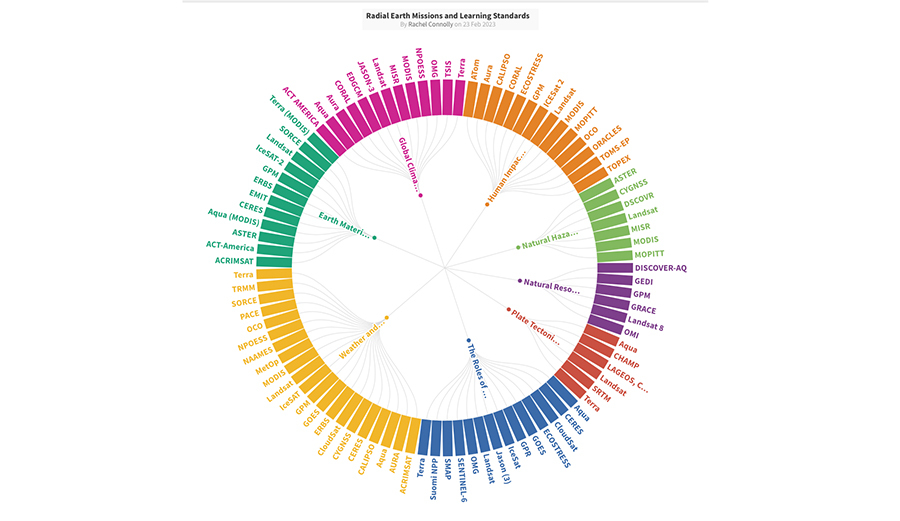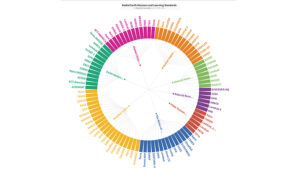Only 3% of water on Earth’s surface is fresh – a vital resource for electricity, farming, and life. As global temperatures rise, disruptions like algal blooms, glacial melt, and drought threaten our aquatic ecosystems. Safeguarding these resources is crucial, and while scientists use a variety of ground-based techniques to gauge water quality, the Landsat program has provided water quality data from orbit for decades. Here are just a few ways Landsat satellites lend us a hand when it comes to monitoring water quality. Credit: Chris Burns, NASA’s Goddard Space Flight Center
/// VIDEO SCRIPT ///
Earth — our home.
A rocky planet whose surface over 70% water — of that 70%, only 3% is freshwater.
It may seem like a small number, but we rely on that 3% every day for electricity, farming, transportation — life as we know it.
As our planet’s temperatures continue to rise, so does the frequency of disruptions to our aquatic ecosystems — algal blooms, glacial melt, mass die offs, pollution, drought.
Managing and safeguarding our water resources has become more important than ever.
Thankfully, scientists have a variety of ground-based methods at their disposal, such as measuring water clarity or tracking pH levels.
For example, assessing how acidic or alkaline a body of water is can be a good indicator of its quality. A sudden change in pH could point to increased pollution or contamination.
Data gathered through ground-based methods is vital to the effort to monitor water quality.
But, for decades, one tool for assessing the health of what lies beneath the water’s surface has kept watch from hundreds of miles above — the Landsat program.
The launch of Landsat 1 in 1972 represented the advent of a revolutionary new era of Earth observation.
Landsat 1’s Multispectral Scanner collected data across four spectral bands.
Data that researchers were quick to put to good use studying vegetation cover, land use, and you guessed it — water quality.
In 1976, researchers from the Environmental Protection Agency harnessed Landsat 1 data to analyze chlorophyl, phosphorus, and nitrogen levels – important water quality indicators — of 100 lakes across the United States.
Decades later, upgrades to instruments across each successive Landsat satellite have underscored what a powerful tool remote sensing can be for global water quality monitoring.
Using satellites to keep tabs on water quality not only ensures the health of aquatic ecosystems, but can also aid in protecting the public health and safety of our communities.
Every year, bodies of water worldwide experience algal blooms like this one due to both natural and human driven factors.
Warm temperatures and excess agricultural runoff can create the perfect environment for algae, including some that are potentially harmful to humans and wildlife alike.
Using satellite data, environmental agencies can not only detect blooms as they pop up but can also issue an early warning to the public about the potential development of these toxic algae.
In 2017, the Utah Department of Environmental Quality used data collected by satellites including Landsat, to detect an algae bloom in Utah Lake much earlier than ground observations alone would have enabled.
This early detection gave health and environmental officials a head-start in posting warnings about the harmful algae bloom, preventing potential exposure
by local fishers, boaters and swimmers, and saving thousands of dollars in insurance costs.
==
This is the Chesapeake Bay, the largest estuary in the United States and no stranger to algal blooms. When it comes to the health of the bay, Landsat’s orbital perspective in time provides scientists with a novel means of tracking trends in watershed-wide land use.
Agricultural runoff is a major contributor to pollution in the Bay as nitrogen, phosphorus and sediment from nearby farms make their way into the Chesapeake, depleting oxygen levels and blocking sunlight from reaching underwater grasses.
But the expansion of nearby urban areas like Baltimore and Washington are also major contributors of aquatic pollutants. As urban areas expand, so does the amount of impervious surfaces like pavement and asphalt, leading to increased stormwater runoff.
This map of Baltimore created using Landsat data shows the dramatic expansion of the city’s impervious surfaces over the course of 26 years.
Pollutants that previously would have been absorbed by the soil or vegetation now flow into the sewer system and in this case, eventually into the Chesapeake Bay.
Data collected by satellites like Landsat allow environmental officials to target areas for conservation and restoration and to more efficiently manage resources. In this case, having an understanding of urban expansion around the bay can aid in the development of unique infrastructure that can counter stormwater runoff, such as bioretention systems that filter pollutants and slow the flow of stormwater into the bay.
Assessing the quality of water bodies like the Chesapeake is just one aspect of managing our water resources, fisheries and aquaculture developments — a task that Landsat has played an important hand in for years.
==
Each year, over 40% of groundwater withdrawals in the U.S. are used for irrigation, watering crops across the country.
As climate change and drought put pressure on the nation’s water supply, particularly in areas across the Western U.S., water conservationists can turn to Landsat for data critical to sustainably manage water resources.
The 30-meter resolution afforded by instruments aboard Landsat satellites allow scientists to track irrigation trends over long periods of time in striking detail.
This map showing the irrigation frequency of fields in the Republican River basin over the course of 17 years was created using data from Landsats 5, 7, and 8.
Zooming into a region along the Colorado-Nebraska border, it’s easy to see the amount of variability in irrigation frequency, with darker colors indicating areas watered nearly every year.
By analyzing economic data, along with Landsat data, researchers believe that part of this irrigation variability can be attributed to crop prices and rainfall.
When crop prices were high, farmers tended to expand irrigation to maximize profits while irrigating more intensely on a smaller number of fields during times of drought. Yearly maps provide a clear insight into irrigation effects and offer precise details on annual changes, guiding better farming water use decisions.
Landslides, past and present, have played a major role in providing critical data about our planet’s water resources, a legacy that will continue with the next generation of Landsat satellites.
In early 2023, NASA and the U.S. Geological Survey announced the development of Landsat Next, constellation of three satellites that will help researchers and users to better identify sources of water pollution and detect and quantify algal blooms, effective management of aquatic food industry and water quality.
The mission’s trio of satellites will have improved spatial and temporal resolution, collecting a complete image of the Earth every six days, allowing users to see features that were too small or happened too quickly for previous Landsat satellites to detect.
Landsat Next’s advanced remote sensing capabilities could prove useful in a future where climate change and population growth continue to put pressure on our planet’s water resources. From what we eat to what we drink, water is fundamental to life on Earth.
Thankfully, Landsat’s view from high above can be counted on to provide accurate and timely data that will help preserve the precious waters below.






